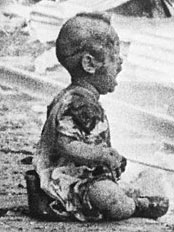 An infant—traumatized, possibly injured and abandoned—was one of many victims when Japanese bombers blasted Shanghai South train station to smithereens in August 1937. “Bloody Saturday.”
An infant—traumatized, possibly injured and abandoned—was one of many victims when Japanese bombers blasted Shanghai South train station to smithereens in August 1937. “Bloody Saturday.”
We know the photographer: H. S. Wong (a.k.a Wong Hai-Sheng, Wang Xiaoting and by his nickname “Newsreel”). The baby’s identity, and fate, is clouded by various competing narratives.The haunting photograph of the crying infant appeared in the October 4 issue of Life magazine: “Without warning…two Japanese squadrons of 8 planes each bombed the civilian Nantao [section of south Shanghai] and leisurely bombed the daylights out of it.” Approximately 200 people were killed, including more than a dozen children.

Wong was the first photographer on the scene after the bombers left. Employed by the Hearst Corporation (the title character of the movie Citizen Kane was based in part on William Randolph Hearst), Wong’s photographs were sent to all Hearst newspapers and some non-Hearst publications—a potential readership totalling some 25 million. Millions more viewed his newsreel footage in movie houses. Life magazine’s headline proclaimed : THE CAMERA OVERSEAS: 136,000,000 PEOPLE SEE THIS PICTURE OF SHANGHAI’S SOUTH STATION
The pictures hit home. “The defence of Shanghai made front-page news. The war picture of a crying baby sitting on tracks in the middle of an empty street had the same emotional impact on newspaper readers as that of the burned child in Vietnam so many years later. The Japanese bombings set off a wave of public sympathy for the Chinese, whose heroism and suffering were reported by American journalists in Shanghai.” (Zara Steiner, Triumph of the Dark, p.523.)
I was first introduced to this photograph by history books claiming that the baby was abandoned. In fact, one of Wong’s photos shows the baby being attended to by a man who Wong identifies as the baby’s father. The Life article also carried another photograph of this baby on a stretcher being attended by a Chinese Boy Scout.

Another important photograph almost certainly exists, one that I have never seen. Wong reported that the body of the baby’s mother was nearby. An experienced professional, Wong almost certainly photographed the dead woman.
[Added 10 April 2024: Another baby, easily overlooked, appears on the bottom right corner of the above photograph. But is it a human baby? A doll? If it is a child, why has this part of the photograph not drawn more attention?] [Wikipedia entry “Bloody Saturday (photograph) provides considerable information (and opinion) about the identity of the baby, and whether the photography was staged.]
The propaganda value was enormous, and Japanese officials were quick to react. They claimed that the incident was staged.
In 2020, the baby was identified as Ping Mei on wikemedia photo of the day.
Originally posted: June 2023.
###